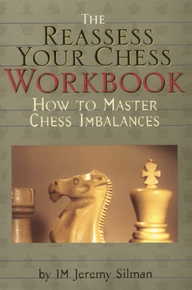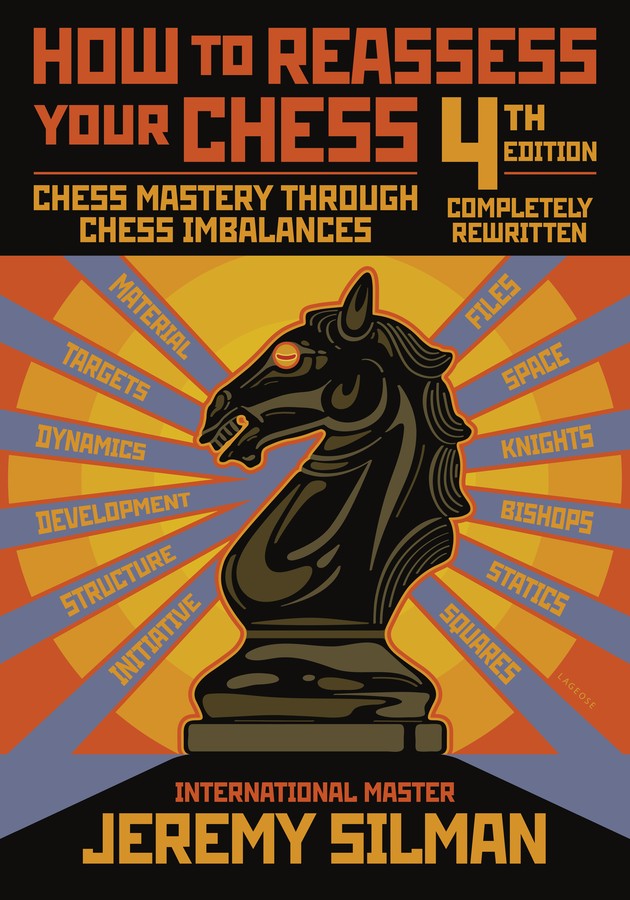| Nivå | B-C |
| Utgivelsesdato | Desember 2010 |
| Forfatter | |
| Pris | 440 NOK |
How to Reassess Your Chess 4th ed
Chess Mastery through Chess ImbalancesDen nyskrevne fjerdeutgaven av Silmans lærebok-bibel for alle spillere med ratingstyrke 1200 - 1900 virker akkurat så imponerende som forventet, og med 658 sider hele 250 sider større enn tidligere.
Boka tar først og fremst tak i det avgjørende viktige området strategisk forståelse, som basis for all god spilleføring i åpning og midtspill. Jeremy Silmans hovedkonsept er "ubalanser" (imbalances) til enhver tid mellom ulike faktorer hos hvit og svart og hvordan disse gir grunnlaget for spilleføringen.
Boka gir en flott blanding av teori, eksempler og praktisk øving, og her er det naturlig eksempler både med verdensmestere og amatørspillere i aksjon. Silman tar tak i deg og holder det gjennom hele boka, om du vil.
Vi tillater oss her å sitere en begeistret Stig K. Martinsen, nå senere både mester- og elitespiller, som fortalte at How to Reassess Your Chess (den forrige utgaven) hadde brakt nesten ene og alene, mente han, ratingen hans opp fra ca 1500 til 1900. Noen mer positiv attest for en lærebok i sjakk har vi ikke hørt på norsk jord...
På boka selv opplyses hovedmålgruppen å være spillere med rating 1400 - 2000, men dette er amerikansk rating som på dette nivået kan regnes å ligge ca 100-150 over norsk rating.
Innholdsfortegnelsen
- Preface xi
- Acknowledgements xii
- Introduction xiii
- Part One / The Concept of Imbalances 1
- Imbalances / Learning the ABCs 3
- Superior Minor Piece — Bishops vs. Knights 4
- Pawn Structure — Weak Pawns, Passed Pawns, etc. 5
- Space — The Annexation of Territory 6
- Material — The Philosophy of Greed 7
- Control of a Key File — Roads for Rooks 8
- Control of a Hole/Weak Square—Homes for Horses 8
- Lead in Development — You’re Outnumbered! 9
- Initiative — Calling the Shots 10
- King Safety — Dragging Down the Enemy Monarch 11
- Statics vs. Dynamics — The Battle Between Short Term and Long Term Imbalances 12
- Planning — Creating Your Own Future 13
- Talk to the Board and It Will Talk to You 23
- Summary 28
- Part Two / Minor Pieces 29
- Knights / Psychopaths of the Chessboard! 31
- Summary 50
- Knights – Tests 52
- Bishops / Speed Demons of the Diagonals 54
- The Active Bishop 54
- The Useful Bishop 58
- The Tall-Pawn 62
- Bishops of Opposite Colors 69
- Summary 74
- Bishops – Tests 75
- Bishops vs. Knights / Grudge Match 77
- Feeling the Minor Piece Tension 78
- The Two Bishops 83
- Two Bishops Antidote — Trade One Off 83
- Free Range Bishops Are Happier Bishops 85
- Bishops vs. Knights 87
- The Great Breakout 87
- The Incarcerated Knight 91
- Pawns and Squares Often Determine a Minor Piece’s Value 92
- Even the Most Innocent Pawn-Move Can Potentially Weaken a Square 93
- All Pawns on One Side of the Board = An Octopus’ Garden 97
- Mr. Knight Prepares to Take a Journey 99
- Summary 102
- Bishops vs. Knights – Tests 103
- Part Three / Rooks 107
- Rooks / Files, Ranks, and Targets 109
- Creating an Open File 109
- Stealing an Open File 114
- Waiting to Pull the File-Opening Trigger 116
- Control of the 7th or 8th Ranks 119
- Summary 130
- Rooks – Tests 131
- Part Four / Psychological Meanderings 133
- Material / Fear of Giving Up or Taking Material 135
- Stepping Beyond Fear 135
- Embracing Your Inner Greed 142
- Imbalances vs. Material 144
- The Stockholm Variation of the Classical Dragon 149
- Catalan Opening 150
- Ruy Lopez, Marshall Attack 151
- Summary 154
- Material – Tests 155
- Mental Breakdown / Overcoming the Trap of “I Can’t” and “I Must” 158
- Bowing to Panic 158
- It’s My Party and I’ll Move What I Want To 160
- The Eerie Phenomenon of Mutual Delusion 163
- The Curse of “I Can’t” 167
- Summary 172
- Mental Breakdown – Tests 174
- Macho Chess / The Art of Insistence 176
- Pushing Your Own Agenda 176
- Key Positions 187
- Summary 194
- Macho Chess – Tests 195
- Various States of Chess Consciousness 197
- Lack of Patience 201
- Lazy/Soft Moves 208
- Pay Attention! 217
- Summary 220
- Various States of Chess Consciousness — Tests 221
- Part Five / Target Consciousness 223
- Introduction 225
- Weak Pawns / The Sound of Ripe Fruit Falling 227
- The Isolated Pawn 227
- The Backward Pawn 235
- Doubled Pawns 239
- The Irish Pawn Center 244
- Summary 246
- Weak Squares 248
- Summary 258
- Dragging Down the Central Enemy King! 259
- Summary 273
- Target Consciousness — Tests 274
- Part Six / Statics vs. Dynamics 277
- Statics vs. Dynamics 279
- Boxer vs. Puncher — A Battle of Opposing Philosophies 279
- Statics vs. Dynamics in the Openings 283
- Summary 297
- Statics vs. Dynamics — Tests 298
- Part Seven / Space 301
- Crushing Your Opponent in Space’s Embrace 303
- The Great Land Grab 303
- Dueling Spatial Plusses 316
- Fighting Against Space 323
- Exchange Pieces! 323
- Use Pawn Breaks! 325
- Gains in Space = Potential Weak Squares 332
- Space-Gaining Pawn Center Might be a Target 337
- Summary 348
- Space — Tests 350
- Part Eight / Passed Pawns 353
- Baby Queens on the Run 355
- Creation 356
- ALittle Help From Its Friends 360
- Passed Pawn Tango 363
- The Dynamic Passer 364
- Three Kinds of Useless Passed Pawns 367
- Blockades 374
- Failed Blockades 374 Successful Blockades 379
- Blockade — Caveat (Obicem) Emptor 381
- Summary 385
- Passed Pawns — Tests 386
- Part Nine / Other Imbalances 389
- Imbalances in the Opening 391
- Creating an Opening Repertoire 391
- Integrating Imbalances With Your Opening Choices 393
- Waylaid into Opening Chaos 416
- Summary 420
- Imbalances in the Opening — Tests 421
- Mixing Imbalances 424
- Mixing Imbalances — Tests 424
- Answers to Tests 429
- Appendix / Instructive Articles 611
- Introduction 613
- Imbalances 613
- Help! I Need a Plan! 616
- Two Questions on Planning 625
- The Art and Science of the Isolated d-Pawn 627
- The Art of Stealing Opening Ideas 631
- Creating a Study Program 636
- The Study of Master Games 639
- Offering a Draw 641
- Proper Tournament Diet 643
- Is Chess a Gentleman’s Game? 644
- Teaching Chess to Children 646
- Bibliography 647
- Index of Concepts 649
- Index of Players and Games 652
2011 Guardian Chess Book of the Year!!
How to Reassess Your Chess has long been considered a modern classic. Now, this fourth and final edition - COMPLETELY REWRITTEN AND FEATURING ALL NEW EXAMPLES - takes Silman's groundbreaking concept of imbalances to a whole new level.
Designed for players in the 1400 to 2100 rating range and for teachers looking for a ready-made chess curriculum, the author shares a mind-expanding journey that takes the reader through imbalance-basics, ensures that every detail of all the imbalances are mastered, and leaves the player/lover of chess with something he always wanted but never believed he could achieve: a master-level positional foundation.
A section on practical chess psychology (titled Psychological Meanderings) presents never-before-published ideas on psychological processes that hinder players of all levels, and gives easy-to-follow advice and techniques that will help anyone overcome these ubiquitous mental/emotional failings.
Hundreds of games brought to life by instruction-rich prose, and stories that offer humor while highlighting various lessons, vividly illustrate all the book's topics in a manner that's both personal and fun.
If the positional masterpieces of the chess legends have always been a mystery to you, if chess strategy has always been an unsolvable enigma, if you find yourself a positional pawn rather than a positional master, then How to Reassess Your Chess, 4th edition will prove to be a life-changing experience.
Jeremy Silman is an International Master and a world-class teacher, writer, and player who has won the American Open, the National Open, and the U.S. Open. Considered by many to be the game's preeminent instructive writer, he is the author of over thirty-seven books, including Silman's Complete Endgame Course, The Amateur's Mind, The Complete Book of Chess Strategy, and The Reassess Your Chess Workbook.
Daniel King, The Guardian: "Everything he talks about is practical and relevant. He discusses common problems and common positions in detail, but the book is also personal and anecdotal in a way that brings examples and ideas vividly to life (..) Excellent value."
| Innbundet? | Nei |
| Type | Bok |
| Førsteutgave år | 1993 |
| Språk | Engelsk |
| Antall sider | 658 |
Produktet er en del av serien Jeremy Silmans lærebokserie
Bøkene av den amerikanske IM Jeremy Silman har fått nesten legendestatus som instruksjon særlig for alminnelige klubbspillere med kanskje rating omlag 1000 - 1700 som reelt vil komme videre og øke spillestyrken. De er mer eller mindre for samme nivå, så rekkefølgen mellom dem er faktisk ikke opplagt. Men de anbefales!
Se også
-

The Reassess Your Chess Workbook How to Master Chess Imbalances
KjøpEn god og spennende oppfølger til Silmans suksessbok "How to Reassess Your Chess". Denne kan med fordel leses og studeres etter den nevnte, men kan også tas i bruk uten å ha gjennomgått noe annet stoff av Silman før.
- Pris
- 295
- Nivå
- B-C
- Av
- Utgivelsesdato
- Oktober 2001

